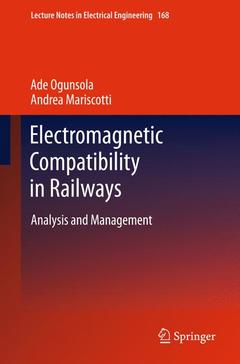Description
Electromagnetic Compatibility in Railways, 2013
Analysis and Management
Lecture Notes in Electrical Engineering Series, Vol. 168
Authors: Ogunsola Ade, Mariscotti Andrea
Language: English
Subject for Electromagnetic Compatibility in Railways:
Approximative price 210.99 €
In Print (Delivery period: 15 days).
Add to cart528 p. · 15.5x23.5 cm · Paperback
Description
/li>Contents
/li>Comment
/li>
A railway is a complex distributed engineering system: the construction of a new railway or the modernisation of a existing one requires a deep understanding of the constitutive components and their interaction, inside the system itself and towards the outside world. The former covers the various subsystems (featuring a complex mix of high power sources, sensitive safety critical systems, intentional transmitters, etc.) and their interaction, including the specific functions and their relevance to safety. The latter represents all the additional possible external victims and sources of electromagnetic interaction.
EMC thus starts from a comprehension of the emissions and immunity characteristics and the interactions between sources and victims, with a strong relationship to electromagnetics and to system modeling. On the other hand, the said functions are achieved and preserved and their relevance for safety is adequately handled, if the related requirements are well posed and managed throughout the process from the beginning. The link is represented by standards and their correct application, as a support to analysis, testing and demonstration.
Recent research on electromagnetic compatibility (EMC) applied to railway systems
Focuses on the principles and application of EMC concepts to railway signalling, communications, power/traction and rolling stocks
Written by leading experts in the field




